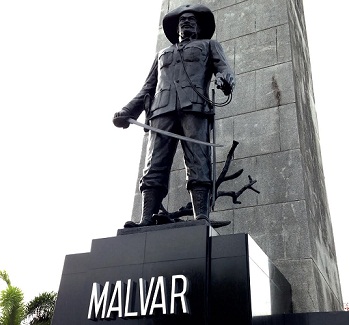
By NORMAN SISON
IF there is anything that the town of Santo Tomas is best known for, it would be bulalo, a light colored stew of beef shanks and — the star attraction — bone marrow. Cholesterol heaven.
With Mount Makiling looming kilometers away, the largely farming town of 125,000 is a popular stopover for travellers. Restaurants serving bulalo line up the highway connecting the town with Manila to the north and the rest of Batangas Province to the south. It even boasts a Starbucks, notwithstanding Batangas’ famed barako coffee.
A road sign at a highway junction outside Santo Tomas is all that gives travellers an idea that the town is also home to a revolutionary war hero.
Maj. Gen. Miguel Malvar (1865-1911) once led a war against America and — if you want to stretch it — assumed the presidency of the Philippines during the conflict. However, unlike historical figures Jose Rizal, Andres Bonifacio and several others, Malvar is inexplicably among the lesser known ranks in the Philippines’ pantheon of national heroes.
A sepia-colored photo shows Malvar, in his rayadillo uniform, with a steely gaze — a “veteran with a satanic beard”, described American journalist Stanley Karnow in his book “In Our Image: America’s Empire in the Philippines.”
Malvar fought in the 1896 revolution against Spanish colonial rule, commanding forces in Batangas. Following the revolution’s defeat, he was exiled to Hongkong along with revolutionary leader and first Philippine president Emilio Aguinaldo and several others.
After returning from Hong Kong, he rose to the rank of major general in the Ejercito Republicano Filipino — the nascent Philippine Army — when the revolution resumed in 1898.
In February 1899, however, war broke out between the Philippines and the United States. America had refused to recognize Philippine independence and took over from Spain as the new colonial master. It was in the Philippine-American War, listed in US history books as the Philippine Insurrection, in which Malvar would earn his place in history.

Malvar took overall command of the revolutionary forces following Aguinaldo’s capture by US forces in March 1901 — and, in line with Aguinaldo’s succession decrees — the Philippine presidency as well. His appointment was approved by the ruling revolutionary committee.
“Perseverance, perseverance and always perseverance, without fear of sacrifice,” Malvar rallied his troops in a manifesto dated July 13, 1901. “Let us continue, as the will of the people has always been more powerful than the most powerful armies.”
Malvar reorganized the army’s command structure and divided the country into autonomous military zones. By that time, however, Malvar and Gen. Vicente Lukban on Samar Island were the only ones who had considerable forces capable of resisting the Americans.
Malvar waged a guerrilla war of attrition, a strategy predating the Vietnam War generations later.
“It is really all a smaller power has as an option when fighting a superpower,” says American history professor Brian Linn, who has studied the Philippine-American War. “They did not challenge their enemies on the battlefield. They worked hard at disciplining their forces to prevent abuses on Filipino civilians, they practiced hit-and-run raids, they controlled the information getting to the enemy, and they dragged out the war in hopes the Americans would get tired and quit.”
Unlike most of his fellow generals, Malvar adopted measures to build a mass base among the populace, realizing that he could not win without support from the people.
“Malvar had imposed his stamp on his native province’s resistance movement in a way few other leaders were able to do,” wrote Linn in his book “The Philippine War 1899-1902”, describing the general as one of the war’s “excellent regional guerrilla commanders.”
Malvar’s guerrilla tactics and the stiffness of the resistance in Batangas moved one Lt. Col. Leonard of the US Army to complain that “more weight is given to this brigand than he is entitled to.”
To force Malvar out, US forces under Maj. Gen. Franklin Bell, adopted scorched earth tactics beginning in January 1902. The populace was herded into controlled zones. Rice fields and towns were torched. Suspected revolutionaries and their supporters were tortured and, in many cases, executed.
Finally, on April 13, 1902, deserted by his men and with his wife dangerously ill, Malvar surrendered. “I found myself without a single gun or clerk,” he said, emphasizing that he didn’t want to add further hardship on the people.
An elated US President Theodore Roosevelt declared victory on July 4, 1902, to placate a US public that had grown weary of the war. Sporadic fighting persisted until 1907, however.
Malvar declined any position offered by the American colonial government and returned to his profession as a farmer. He died of liver failure in 1911 and was buried in Santo Tomas. Among those who attended his funeral was Bell.
Today, Malvar isn’t recognized as the Philippines’ second president. Two other revolutionary generals, Antonio Luna and Gregorio del Pilar, are more famous than him. A Philippine Navy corvette, the BRP Miguel Malvar, dates back to World War II. The Philippine Army’s website doesn’t include Malvar in its roster of commanding generals.
But justice is finally coming.
Next year, the National Historical Commission of the Philippines will open a museum in Santo Tomas to celebrate the 150th anniversary of Malvar’s birthday on September 27. Outside is a statue designed by nationally acclaimed sculptor Napoleon Abueva. It depicts Malvar with saber and revolver drawn — defiant to the end.
